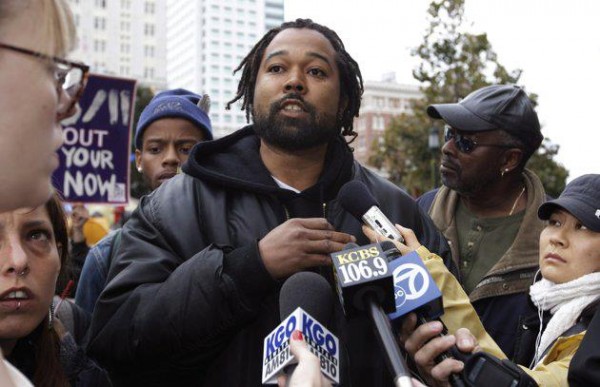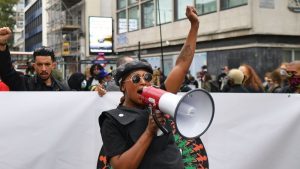
Sometimes the medium is the message. Whether you hate corporate media, are a news junkie, or a little of each, press coverage matters.
9 practical tips on how to get better coverage on TV, print, and online follow. They’ve worked for me; your mileage may vary.
1. Timing.
Schedule events during prime times, inviting reporters in advance. You’re competing with crime, layoffs, traffic, and Snooki for viewer attention. If you live in a #newsdesert like Oakland or Denver where newspapers are failing and reporters only show up after a shootout, this is even more of an challenge.
Events between Monday noon and Thursday rush hour get the most coverage. Friday and Saturday are a dead zone. Few senior journalists work weekends, although they need stories filed for Monday morning.
Try not to schedule actions at the same time as everyone else. Occupy Bernal has gotten a lot of good press thanks to a crack media team. But when they and ACCE held a foreclosures action at the same time as Tony Bennett at City Hall, you can guess where the newscameras went.
TV news is on from 5-8 am and 5-7 pm, and again 10-11:30 pm. The final OccupyOakland clearing on November 10 was a Sunday night/Monday beginning around 3 am which hit 6 am EDT and got picked up nationally on East Coast coming back from weekend.
Unfortunately all it showed was an outrageously disproportionate response by 1000 officers in riot gear. The message the public got: Occupy is over.
How to get no coverage:
- Hold your events between Friday night and Sunday afternoon. Saturday daytime events get a little coverage, but no one watches TV Saturday or Sunday night, and top reporters are off.
- Use Twitter and Facebook to spread the word. Sorry to disappoint, but TV producers and editors aren’t following your Twitter feed 24/7. The feds are a different story ; )
2. Make their jobs easy.
Mainstream media isn’t monolithic. There are meaningful differences between stations and reporters and editors and news websites that do original reporting. Sympathetic journalists often don’t make decisions, though they do pitch stories. Newspapers have been laying off reporters for more than 10 years.
Keep lists of all possible media contacts ahead of events: TV, papers, radio, magazines, blogs like Huffington Post. Don’t forget about national outlets like The Nation, Mother Jones, AlterNet, NPR, Slate, Salon, and Democracy Now as well as the Guardian UK.
Have easy ways to email multiple contacts and play the rivalries of stations and magazines against each other. No one wants to be scooped on a big story.
Have a designated Occupy press contact at each action. This person doesn’t need to answer every question but directs press to the right people who can. If a reporter asks, “What do Bay Area residents think about the proposed millionaire’s tax?” introduce them to Mrs. Jones.
Provide media with a single point-of-contact for followup: a Google voice # and an shared email/Twitter account work as long as it’s clear who’s using it and how they can speak for others. Follow up quickly; print and broadcast have hard deadlines. Email is best if you don’t wan’t to worry about calling/texting too late or too early.
Take advantage of talented Occupiers: photographers, graphic designers, writers, illustrators, and editors. Prepare press kits and post them online.
A press kit can be as simple as a flyer explaining an event (WHO, WHAT, WHERE, WHEN, and especially WHY), a couple of quotable quotes, and contact info. Link to video or photos they can use (watermarked with #OccupyXYZ) if you want them to use your flattering, well-labeled pictures.
Update the press kit after the event and notify everyone on your list, whether they attended or not. It’s never too late to get good press or accurate information.
Don’t forget to recap for a newly assigned reporter and his audience.
3. Watch your mouth.
Language is powerful, and winning hearts and minds begins with first impressions. This movement has come far on the simplicity and inclusiveness of its messaging (we are the 99%). Calling people “sheep,” “parasites,” and “fascists” is a great way to alienate supporters and be labeled extremists.
Don’t threaten the public with retaliation or violence unless you want to be met with a police (or worse, DHS) response.
Consider broadcast limitations on profanity. “Fuck the Police” is something you can type on Twitter and shout in the street. But it’s not something mainstream newspapers, TV, or radio stations will air. If you use language that journalists can’t, they will be forced to make shit up.
Either Occupy controls the narrative, or we cede control.
Please don’t:
- Tell reporters they’re liars or curse at them.
- Yell at them when they come cover an event.
- Threaten vans or vandalize equipment.
This pretty much guarantees negative coverage, which works for those who would like this movement to shut up and go away.
4. If it bleeds, it leads.
TV news is powered by ratings and sensationalism. A picture is worth 1000 words. Use them effectively, but don’t be surprised when they’re used against you.
One of the most enduring and powerful images of Occupy Oakland: a flag.
Compare the use of a rainbow peace flag at an Interfaith rally in front of Oakland City Hall with the burning American flag inside City Hall on #J28, which made national TV news and solidified local opposition to Occupy.
An upraised fist symbolizes solidarity. But a fist also represents socialist oppression to people who fled Soviet republics and reminds others of the doctrine of violence espoused by the Black Panthers, especially when combined with language like “smash the state.” An uneasy public is not sure how literal the smashing is going to be and hears violence.
Understood: this is a protest movement. Many images and slogans are intended to be unsettling. The question isn’t diluting the power of your message but how to avoid having it upstaged by loaded imagery.
5. Talk about one thing at a time. Repeat until heard.
Make it easy for reporters and audiences by simplifying issues, even if the underlying issues are complex. The beauty of “We are the 99%” is it didn’t require an explanation about the evils of Capitalism or the repeal of Glass-Steagall.
Focus on the specifics of the action at hand and its benefit to the community: ”We’re here to stop Maria Delgado from being evicted from her home of 40 years.” “I’m a student with $100,000 in debt and I don’t even have a degree.” “I’m asking Wells Fargo, which made billions of dollars in profits and received federal bailout money, to modify this loan and stop this foreclosure.” Be known by your deeds.
Don’t insist that everyone buy into your personal grand unified Occupy world view. You may care passionately about prisoners rights and Syria while I’m committed to marriage equality and voter ID laws. We can and should work together on holding banks and Wall Street accountable.
Occupy Wall Street is about abuse of power and a system that favors those with lots of money over opportunities and fair policies for all. It’s about foreclosures, income inequity, accountability of financial institutions. When you get far beyond issues of money and power, expect to lose some people.
6. Look smart.
Dress for success. Be sexy. Be interesting. Don’t be a #hairhatecrime.
Be honest and speak from the heart. People known when they’re being talked down to or spun.
Being on TV is like a job interview. Journalists and viewers make instant judgments based on your appearance, your name, their preconceptions. They may not listen to what you have to say. Look like someone in charge of her destiny, a leader in a leaderless movement, one where each voice is important.
 Costumes are great because they show a sense of humor and sophistication. Subcomandante Marcos from Chiapas in the 90s wore a ski mask and dressed in black with a signature pipe and cool demeanor that helped him gain worldwide attention and sympathetic press for the zapatistas.
Costumes are great because they show a sense of humor and sophistication. Subcomandante Marcos from Chiapas in the 90s wore a ski mask and dressed in black with a signature pipe and cool demeanor that helped him gain worldwide attention and sympathetic press for the zapatistas.
Code Pink does this really well; they make onlookers curious and they make you smile. Captain America has been spotted at Occupy Oakland.
Put beautiful and beautifully dressed occupiers in front of TV cameras. (And no specific notion of beauty is implied: show off the diversity of the movement.)
Don’t be afraid to admit you’re nervous, or ask someone madly scribbling notes to repeat what you said. Ask to review a draft before it goes to press; confirming facts & quotes makes for accurate stories.
Visualize viewers as your neighbors: maybe skeptical or half-supportive neighbors, maybe cheering neighbors out on their porches. You’ll never meet most of these people, but they donate money and supplies, write emails and make phone calls, talk to friends and coworkers, and vote.
Occupiers are remarkably resilient and hopeful. Remember what’s been accomplished in such a short time and bring that energy to any interview you do.
If you’re exhausted, frustrated, spitting mad, or haven’t eaten in 10 hours, let someone else do the interview.
7. Take the long view.
Be patient. Cultivate relationships. Just because Channel 2/4/6/8 had coverage that left something to be desired last night, don’t give up on getting the message out.
Look on the bright side: they’re still sending people to your events. Reporters assigned to the same beat over time tend to go deeper and address more complex issues; they get invested.
Journalists rely on knowledgable sources. Become that source for them, so they sound like they speak from inside the scene. When correcting them—and they will need corrections—do it without calling them fucking morons.
If you and I won’t talk to reporters respectfully or at all, they’ll get their information 3rd hand or from propaganda sources like the police department and bank PR group. Or from their own biases.
Facing a news camera isn’t any more worse than facing riot police. Don’t be afraid to mess up; everyone does. Bring a friend with you. The more you speak to newscameras, the easier it gets. (You’ll still hate your hair.)
Good intentions go a long way.
8. Thank journalists who do a good job.
Do this publicly and often. It will pay off in spades down the line.
Journalists spend more time on stories that reward them. Especially on a Saturday when they could be having dinner with their kids instead of at Santa Rita or worrying about being pepper sprayed.
There’s no stronger ally than a journalist who has been denied access by police or arrested.
9. Be original.
The first Wild Old Women protest was news. The 10th isn’t. That’s not censorship, just the way media and public attention work.
Another Occupy protest or raid isn’t news. 2000 students and supporters fighting education cuts in the rotunda in Sacramento is.
Humor helps. It shows you don’t take yourself too seriously, even if the issues themselves are serious. TV producers like amusing events and subjects. Foreclosures and unemployment are depressing enough.
Keep it short. At best you’ll get 1 minute on the 10 o’clock news. Long speeches won’t be covered unless you’re famous or infamous. (Try not to be infamous.)
“If you don’t like the news, go out and make some of your own.”
—”Scoop” Nisker
Examples of effective Occupy coverage:
NYT city room blog on M17
A Liberal and a Radical Battle for Control of a Movement
Crowd Control at Oakland Protests
What were your favorite stories of the past six months, the ones you shared proudly (or nervously) with your parents or co-workers? How can we get more like them?








